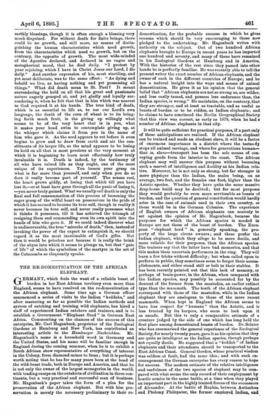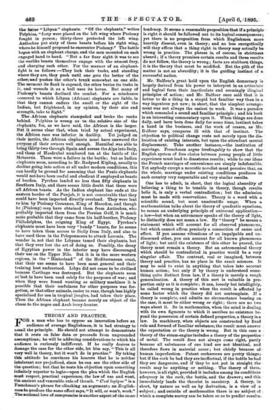THE RE-DOMESTICATION OF THE AFRICAN ELEPHANT.
GERMANY, which feels the want of a reliable beast of burden in her East African territory even more than England, seems to have resolved on the re-domestication of the African elephant. Some time ago a German officer commenced a series of visits to the Indian " keddahs," and after mastering so far as possible the Indian methods and system of catching and training wild elephants, has hired a staff of experienced Indian catchers and trainers, and is to establish a Government "Elephant Stud" in German East Africa. Commenting on the chances of the success of this enterprise, Mr. Carl Hagenbeck, proprietor of the Zoological Gardens at Hamburg and New York, has contributed an interesting article to the Hamburger Nachrichten. Mr. Hagenbeck's name is a household word in Germany and the United States, and his name will be familiar enough in England during the coming summer, when he is to exhibit a South African show representative of everything of interest in the Colony, from diamond-mines to lions ; but it is perhaps worth noting that he has for many years been at the head of the wild-beast trade, both in Europe and America, and that he is not only the owner of the largest menageries in the world, with trading-camps on the outskirts of civilisation in three con- tinents, but a very practical and successful man of business. Mr. Hagenbeck's paper takes the form of a plea for the preservation of the African elephant. But with him pre- servation is merely the necessary preliminary to their re-
domestication, for the probable success in which he gives reasons which should be very encouraging to those now pledged to the undertaking. Mr. Hagenbeck writes with authority on the subject. Out of two hundred African elephants brought to Europe in recent years he has imported one hundred and seventy, and many of these have remained in his Zoological Gardens at Hamburg and in America. With the histories of the rest since they passed into other hands he is perfectly familiar. He was recently able to tell the present writer the exact number of African elephants, and the owner of each in the different countries of Europe; and he has a natural insight into the ways and means of animal domestication. He gives it as his opinion that the general belief that "African elephants are not so strong as, are wilder, and less easily tamed, and possess lees endurance than, the Indian species, is wrong." He maintains, on the contrary, that they are stronger, and at least as tractable, and as useful as beasts of burden or to be ridden, as Indian elephants ; and he claims to have convinced the Berlin Geographical Society that this view was correct, as early as 1878, when he had a number of African elephants in that city.
It will be quite sufficient for practical purposes, if a part only of these anticipations are realised. If the African elephant can be trained and made an obedient slave, it will be a factor of enormous importance in a district where the tsetse-fly stops all animal carriage, and where for generations human— that is, slave—transport has been the sole means of con- veying goods from the interior to the coast. The African elephant may well answer this purpose without becoming such a marvel of intelligence and docility as his Indian rela- tive. Moreover, he is not only as strong, but far stronger in mere physique than the Indian, the males being, on an average, two feet, and the females one foot, higher than the Asiatic species. Whether they have quite the same massive dray-horse build may be doubted ; but for most purposes they would probably be even more serviceable as beasts of burden, and the question of general constitution would hardly arise in the case of animals used in their own country, as these would be in the German Colonies. The experience of English owners of African elephants can scarcely be set against the opinion of Mr. Hagenbeck, because the purposes for which the African species is needed in Europe are not those of the beast of burden. The Euro- pean "elephant herd" is, generally speaking, the pro- perty of the large circus owners ; and these prefer the Indian elephant, which they allege to be more docile, and more reliable for their pm-poses, than the African species. The trainers say that the latter have bad memories, and that this makes them uncertain performers in the ring. They will learn a few tricks without difficulty ; but when called upon to perform in public, they sometimes seem to forget their accom- plishments, and either stand still or bolt to their stables. It has been recently pointed out that this lack of memory, or perhaps of brain-power, in the African, when compared with the Indian species, may possibly be accounted for by the descent of the former from the mastodon, an earlier extinct type than the mammoth. The teeth of the African elephant correspond with those of the mastodon, while in the Indian elephant they are analogous to those of the more recent mammoth. When kept in England the African seems to have less respect for " humans " than the Asiatic, and is less trusted by its keepers, who seem to look upon it as unsafe. But this is only a comparative estimate of a creature judged by the side of one which has long held the first place among domesticated beasts of burden. Dr. Mater who has summarised the general experience of the Zoological Society, for nearly twenty years, gave it as his opinion that they are quite as intelligent as the Indian species, though perhaps not equally docile. He suggested that a " keddah " of Indian elephants and their attendants should be transported to the East African Coast. General Gordon, whose practical wisdom was seldom at fault, had the same idea ; and with such en- couragement the German enterprise has every reason to hope for success. The modern estimate of the relative intelligenoe and usefulness of .the two species of elephant may be com- pared with what seems the only record of their employment by hostile armies in the same battle, at a time when they played an important part in the highly trained forces of the successors of Alexander. At the battle of Raphia, between Antiochus and Ptolemy Philopator, the former employed Indian, an
the ratter " Libyan " elephants. "Of the elephants," writes Polybins, "forty were placed on the left wing where Ptolemy fought in person; thirty-three protected the left wing.
Antiochus put sixty of these beasts before his right wing, where-he himself proposed to encounter Ptolemy." The battle beganwith an elephant charge, and the men mounted on each engaged hand to hand. "Bat a far finer sight it NM to see the warlike beasts themselves engage with the utmost fury,
and charging each other. For the manner of an elephant- fight is as follows :—They look their tusks, and standing where they are, they push until one gets the better of the other, and pushes the other's trunk somewhat on one side. The moment its flank is exposed, the other buries its tusks in it, and wounds it as a bull uses its horns. But many of Ptolenry's beasts declined the combat. Foe a mischance occurred to which Libyan (African) elephants are liable, in that they cannot endure the smell or the sight of the Indian, but frightened, in my opinion, by their size and strength, take to flight."
Tho.African elephants stampeded and broke the ranks behind. Polybins is wrong as to the, relative size of the elephants, for, as we have said, the African is the larger. But it seems clear that, when tried by actual experiment, the African race was inferior in docility. Yet judged on their merits, the African elephants must have answered the purpose of their owners well enough. Hannibal was able to bring thirty-two through Spain and across the Alps into Italy, and those of Hasdrnbal numbered ten at the battle of the Metanrus. These were a failure in the battle; but as Indian elephants seem, according to Mr. Rudyard Kipling, usually to decline going into action at all under modern conditions, this can hardly be ground for assuming that the Punic elephants would not have been useful and obedient if employed as beasts of burden. Pyrrhus landed no less than fifty elephants in Southern Italy, and there seems little doubt that these were all African beasts. As the Indian elephant line ends at the eastern border of the Punjab, it is not conceivable that they could have been imported directly overland. They were lent to him by Ptolemy Ceram:ins, King of Macedon, and though he (Ptolemy) may have obtained them from Antiochus, who probably imported them from the Persian Gulf, it is much more probable that they came from his half-brother, Ptolemy Philadelphus, the reigning King of Egypt. Pyrrhus's elephants must have been very "handy" beasts, for he seems to have taken them across to Sicily from Italy, and also to have used them in the Peloponnesus to attack Laconia. The wonder is, not that the Libyans tamed their elephants, but that they ever lost the art of doing so. Possibly, the decay of Egyptian power in the interior may have discouraged their use on the Upper Nile. But it is in the more western regions, in the " Hinterland " of the Mediterranean coast, that their use seems to have been most general and their training best understood. Libya did not cease to be civilised because Carthage was destroyed. But the elephants seem at last to have been used solely for the purposes of war; and when they were found wanting as military machines it is possible that their usefulness for other purposes was for- gotten, or that other animals, easier to rear, though less highly specialised for use in tropical jungles, had taken their place. Then the African elephant became merely an object of the chase to the negro and Arab ivory-hunter.







































 Previous page
Previous page